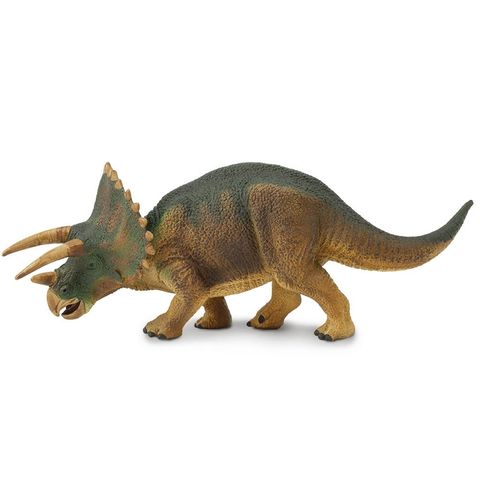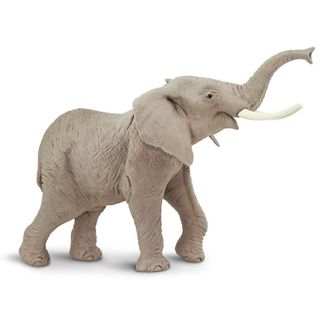
Description
The three-horned Triceratops is the most famous – and most gigantic – of all the horned dinosaurs. This iconic animal browsed for plants in North America during the Late Cretaceous, 65 million years ago.
- Scientific Name: Triceratops horridus
- Characteristics: Triceratops is best known for its horns: a short one on its nose, and a long horn over each eye. Triceratops has a curved beak, and a solid bony frill on the back of its head. It walked on four short robust legs. Its front legs have five toes, of which three have blunt claws, and the hind feet have four large toes with hoof-like claws. At 26 ft long it was one of the largest horned dinosaurs.
- Size and Color: This model is 8 inches long and 2.75 inches high. It is colored in natural shades of green and brown.
- The Triceratops is part of the Wild Safari® Prehistoric World collection
- All of our products are Non-toxic and BPA free
History
Triceratops was the first horned dinosaur ever found, which is why it is so famous. The first fossil of Triceratops was discovered in Colorado in 1887. It consisted of a pair of horns that, at first, were thought to belong to an extinct species of bison. More complete material was unearthed in Wyoming and Montana in the late 1980s and they were recognized as a new type of dinosaur. Today, Triceratops is known from many fantastic skulls and nearly complete skeletons.
Triceratops is a horned dinosaur, more properly known as a ceratopsian. The name Triceratops means ‘three-horned face’ in reference to its three horns. Triceratops’ huge brow horns could reach up to 3.2 feet long in large adult individuals – the height of a human child. These pointed bones are cores that supported a horny sheath, so the horns may have been even longer in life. They may have been used as weapons to protect themselves against predators, or were possibly used for fighting between rival males. The solid bony frill may have been colorful for display, and may have been used as a shield to protect its neck.
Ceratopsians are sometimes referred to as the ‘buffalo of the Cretaceous’ because they lived in large herds. The evidence for this includes footprints of herds of dinosaurs all walking in the same direction, and fossils of multiple ceratopsian skeletons have been found preserved together.
Many species of Triceratops have been named over the years, but today only two species are considered valid: T. horridus and T. prorsus. Triceratops lived alongside the mighty T. rex in North America during the Late Cretaceous, 65 million years ago. So, Triceratops probably kept a wary eye on the horizon at all times.
- Size in cm: 20.5 L x
- Size in inches: 8.07 L x
- UPC: 095866284503








